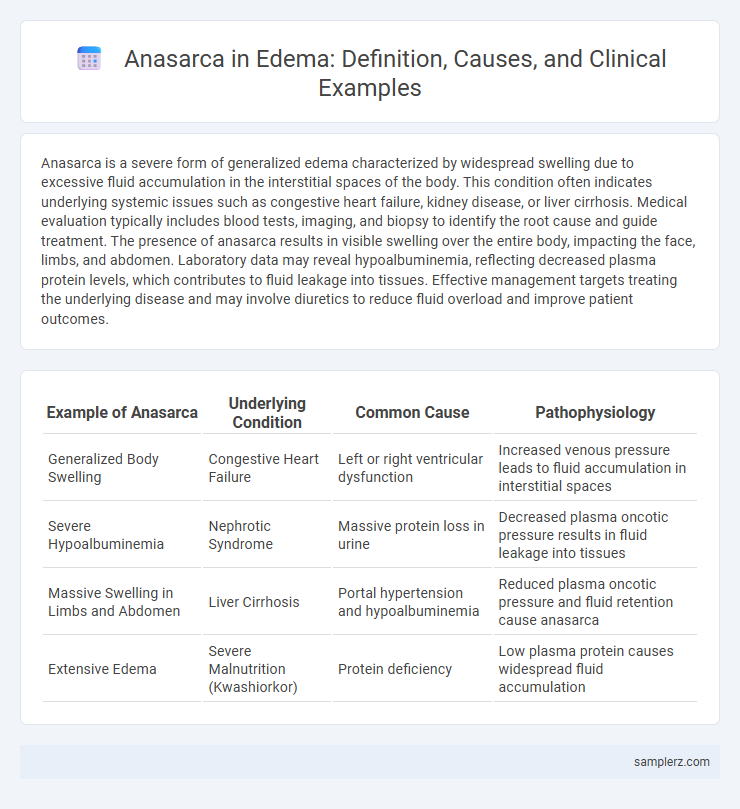Anasarca is a severe form of generalized edema characterized by widespread swelling due to excessive fluid accumulation in the interstitial spaces of the body. This condition often indicates underlying systemic issues such as congestive heart failure, kidney disease, or liver cirrhosis. Medical evaluation typically includes blood tests, imaging, and biopsy to identify the root cause and guide treatment. The presence of anasarca results in visible swelling over the entire body, impacting the face, limbs, and abdomen. Laboratory data may reveal hypoalbuminemia, reflecting decreased plasma protein levels, which contributes to fluid leakage into tissues. Effective management targets treating the underlying disease and may involve diuretics to reduce fluid overload and improve patient outcomes.
Table of Comparison
| Example of Anasarca | Underlying Condition | Common Cause | Pathophysiology |
|---|---|---|---|
| Generalized Body Swelling | Congestive Heart Failure | Left or right ventricular dysfunction | Increased venous pressure leads to fluid accumulation in interstitial spaces |
| Severe Hypoalbuminemia | Nephrotic Syndrome | Massive protein loss in urine | Decreased plasma oncotic pressure results in fluid leakage into tissues |
| Massive Swelling in Limbs and Abdomen | Liver Cirrhosis | Portal hypertension and hypoalbuminemia | Reduced plasma oncotic pressure and fluid retention cause anasarca |
| Extensive Edema | Severe Malnutrition (Kwashiorkor) | Protein deficiency | Low plasma protein causes widespread fluid accumulation |
Understanding Anasarca: A Severe Form of Edema
Anasarca is a severe and generalized form of edema characterized by widespread swelling due to excessive fluid accumulation in the subcutaneous tissues. It commonly occurs in conditions such as congestive heart failure, nephrotic syndrome, and liver cirrhosis, where the body's fluid balance is severely disrupted. Prompt identification and management of underlying causes are essential to prevent complications associated with anasarca.
Key Causes of Anasarca in Medical Conditions
Anasarca, a severe and generalized form of edema, commonly results from key medical conditions such as congestive heart failure, nephrotic syndrome, and liver cirrhosis. These conditions disrupt normal fluid balance by impairing cardiac output, causing protein loss in urine, or reducing albumin production, respectively. Understanding these underlying causes is crucial for effective diagnosis and treatment of anasarca.
Clinical Presentation: How Anasarca Manifests
Anasarca presents as widespread, severe edema characterized by generalized swelling affecting the subcutaneous tissues throughout the body, including the face, limbs, and abdomen. Clinical signs often include taut, shiny, and pitting skin due to extensive fluid accumulation, accompanied by weight gain and difficulty in mobility. This condition frequently indicates underlying systemic issues such as heart failure, liver cirrhosis, or nephrotic syndrome.
Differentiating Anasarca from Localized Edema
Anasarca presents as a severe and generalized edema involving widespread subcutaneous tissue swelling, often caused by systemic conditions such as congestive heart failure, nephrotic syndrome, or liver cirrhosis. Differentiating anasarca from localized edema requires recognizing its diffuse nature, whereas localized edema is confined to specific body regions like the lower limbs or abdomen and typically results from local injury, infection, or venous obstruction. Clinicians use physical examination and diagnostic imaging to distinguish generalized anasarca from localized edema, guiding appropriate treatment strategies based on the underlying etiology.
Common Examples of Diseases Leading to Anasarca
Common diseases leading to anasarca include congestive heart failure, nephrotic syndrome, and liver cirrhosis, which cause extensive fluid retention and generalized swelling. Severe malnutrition, particularly protein deficiency such as in Kwashiorkor, also contributes to anasarca by lowering plasma oncotic pressure. Additionally, conditions like severe hypothyroidism and acute renal failure frequently manifest with widespread edema characteristic of anasarca.
Diagnostic Approaches for Identifying Anasarca
Anasarca, characterized by widespread edema, is diagnosed using clinical examination combined with diagnostic imaging such as ultrasound to assess fluid accumulation in tissues. Laboratory tests measuring serum albumin, renal function, and cardiac biomarkers help identify underlying causes like nephrotic syndrome, heart failure, or liver cirrhosis. Advanced diagnostic tools including chest X-rays and echocardiography provide critical data for evaluating systemic fluid overload and guiding effective treatment strategies.
Case Study: Anasarca in Heart Failure Patients
Anasarca represents severe, generalized edema characterized by widespread fluid accumulation in the interstitial spaces, commonly seen in advanced heart failure patients. Case studies reveal that left ventricular dysfunction leads to increased venous pressure and hypoalbuminemia, precipitating massive fluid retention and swelling in extremities and abdominal cavity. Effective management combines diuretics, improved cardiac function, and addressing underlying causes to reduce morbidity and improve patient outcomes.
Role of Renal Dysfunction in Anasarca Development
Renal dysfunction plays a critical role in the development of anasarca by impairing the kidneys' ability to excrete sodium and water, leading to fluid retention and extensive generalized edema. Conditions such as nephrotic syndrome or acute kidney injury disrupt glomerular filtration and sodium balance, causing increased hydrostatic pressure and decreased oncotic pressure that promotes widespread fluid accumulation. Effective management of anasarca requires addressing underlying renal pathology to restore normal fluid homeostasis and prevent further fluid overload.
Treatment Strategies for Managing Anasarca
Treatment strategies for managing anasarca focus on addressing the underlying cause and reducing excessive fluid accumulation through diuretics such as furosemide and spironolactone. Dietary modifications including sodium restriction and controlled fluid intake play a critical role in minimizing edema. In severe cases, therapeutic paracentesis or albumin infusion may be necessary to alleviate symptoms and improve patient outcomes.
Prognosis and Complications Associated with Anasarca
Anasarca, characterized by extensive, severe edema often linked to conditions such as congestive heart failure, nephrotic syndrome, or liver cirrhosis, presents a complex prognosis dependent on the underlying cause and promptness of treatment. Complications associated with anasarca include impaired tissue perfusion, increased risk of skin infections like cellulitis, and respiratory difficulties due to pleural effusions. Early recognition and management are critical to mitigate potentially life-threatening outcomes and improve patient quality of life.

example of anasarca in edema Infographic
 samplerz.com
samplerz.com